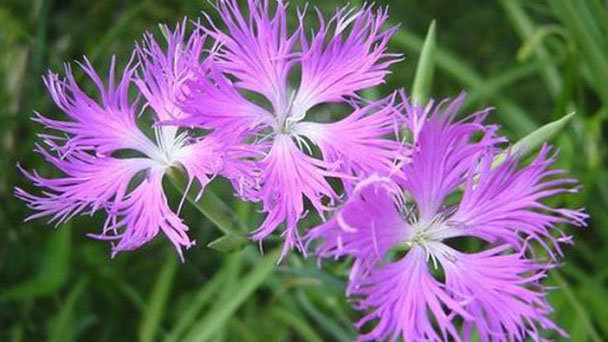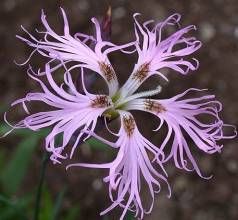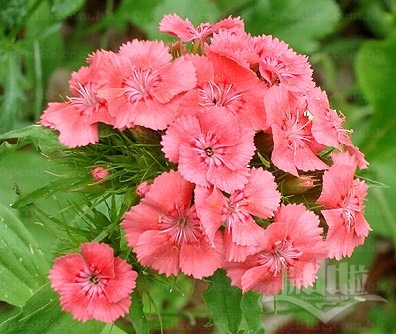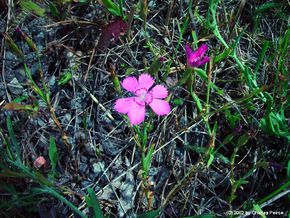Dianthus deltoides (maiden pink) profile
Written by Maggie
Mar 17 2021

Dianthus deltoides (maiden pink) is a perennial plant of the family Dianthus deltoides, native to Europe, West Asia and Scandinavia. The Greek philosopher and naturalist Theopphrastus first named Dianthus, Dios Anthos, referring to the flower of God, Dios Anthos, which is also a flower receiving the blessing of God. The whole plant Dianthus deltoides is grayish green, the plant is low, 15 ~ 40cm tall, with prostrate growth characteristics. Rhizomes rapidly spread, flower stalks erect, less pilose. Herbs are with persistent roots. Dianthus deltoides can be planted in the rock courtyard, suitable for roof greening, potting and flower beds.
Dianthus deltoides picture

Dianthus deltoides info
| Botanical Name | Dianthus deltoides |
| Common Names | maiden pink |
| Plant Type | Herbaceous perennial |
| Sun | Full sun |
| Hardiness Zones | 3 to 8 |
| Flower color | Pink |
| Native Area | Europe, western Asia |
| Mature size | 0.50 to 1.00 feet high, 0.50 to 2.00 feet wide |
Morphological characteristics of Dianthus deltoides
Dianthus deltoides, also known as Maiden Dianthus, is a perennial herbaceous flower, but it is usually cultivated for one or two years. Dianthus deltoides is about 20 centimeters high, red, white or variously colored, branches scattered with a few pink and occasionally white flowers, the edge of the flower into fine tassels, petals for 5 petals.
Dianthus deltoides is a short plant with small, well-distributed flowers at the top of branches, with rosy, purple, and white spots, and a "V" -shaped spot on the throat. The shape is delicate, actually not delicate, can grow in a variety of environments, there is a long sweet fragrance, and can make people feel comfortable and relaxed.
The flowering stage of Dianthus deltoides is in spring, and the fruiting stage is from summer to autumn. Main colors: cherry red, dark red, rose, white, mixed colors.
Ecological habits of Dianthus deltoides
Dianthus deltoides prefer warm, sunny soils that are fertile, well drained, and slightly alkaline. Poor drainage, often resulting in death.
Dianthus deltoides have cold resistance, drought resistance, and heat resistance. In summer, they often grow poorly or wither, so they should pay attention to shade and cooling during cultivation. Dianthus deltoides likes sunny, dry, ventilated and cool humid climates. Maiden Dianthus requires fertile, loose, well drained and calcareous loam or sandy loam, to avoid waterlogging, good fertilizer. Maiden Dianthus was born on grasslands and hillsides.
How to grow and care for Dianthus deltoides
Transplant
Three to four weeks after germination, seedlings of Dianthus deltoides can be transplanted into pots of 9 to 11 cm diameter.
The substrate
Cultivation substrate should be well drained, clay content of 15%, about 15% wood fiber, bark can be added, 1 to 1.5 kg of fully balanced fertilizer per cubic meter of substrate. The matrix should contain iron chelates and micronutrients with a pH of 5.5 to 5.8.
Light
Dianthus deltoides is a medium sunshine plant. Light supplement is required in winter and spring, and the culture should be combined with the temperature of 15℃ to 18℃.
Temperature
The optimum temperature for growth of Dianthus deltoides was 10℃ to 12℃. Under the condition of no frost in winter, the temperature can be kept between 3℃ and 5℃. Plants need to undergo 8 to 10 weeks of vernalization. Plant growth begins at 15℃ to 18℃ for 7 to 8 weeks in spring. Dianthus deltoides plants will grow longer at 8℃ to 10℃ cold temperature and under natural growth conditions. The temperature needs to be above 15℃ to flower.
Fertilizer
Dianthus deltoides require low levels of fertilizer. Completely balanced nitrogen and calcium nitrate fertilizers of 100 to 150ppm can be applied alternately once a week. Avoid high ammonium and nitrogen levels. Dianthus deltoides roots are very sensitive to high ammonium content. Fertilizer should not be applied after mid-September. In spring, a fully balanced nitrogen fertilizer of 130ppm to 150ppm was applied. To prevent magnesium and iron deficiency, one or two times of 0.05% magnesium sulfide and one or two times of iron chelate can be sprayed respectively. Dianthus deltoides roots were also sensitive to the high salt content of the substrate. Concentrated spraying of high concentration of fertilizer should be avoided, and the reasonable way of fertilization should be frequent application of thin fertilizer.
The propagation of Dianthus deltoides
Dianthus deltoides are commonly used for sowing, cuttings, and splitting propagation.
Seed propagation
The optimal temperature for Dianthus deltoides seed germination is 21 to 22℃, and it is generally carried out in September. Sow in the open seedbed, keep the soil moist after sowing, 5 days after sowing can sprout, 10 days or so that the seedlings, the appropriate temperature for seedling growth 10-20℃; The seedlings can be transplanted when 4-5 leaves have been produced and flower in the next spring.
Cutting propagation
Dianthus deltoides were carried out from autumn to spring of the following year. The shoots were cut 5-6 cm long during the lush period. The taproot is inserted 15-20 days after insertion. Splitting propagation is usually carried out in autumn or early spring by using old plants after anthesis.

Disease control of Dianthus deltoides
Dianthus deltoides are often affected by rust and red spider.
Rust
In cleaning garden disease after the timely spray prevention, can spray 2~5 degrees of sulfur mixture or sodium pentachlorophenol 200~300 times the liquid. To prevent and control the rust on the trans parasitic plants, it is necessary to spray 1~2 times in the middle of March to kill the spores of overwintering bacteria.In the growing season, when the new leaves expand, you can choose 25 powder rust ning 1500~2000 times liquid, 50 mancozeb 500 times liquid, or 25 cream copper wettable powder 800 times liquid spray, every 7~10 days 1 time, continuous control 2~3 times. It can be used 50 wilting Ling WP 1500 times liquid spray.
Starscream
Scrape the bark of the overwintering eggs before they hatch and burn them. After scraping the bark, paint the trunk white (lime water) to kill most of the overwintering eggs. According to the rule of overwintering eggs hatching and the habit of feeding and breeding on weeds first after hatching. Pour the ground in early spring to clear weeds on the ground, so that there are no weeds in the field during the incubation of overwintering eggs, so that red spiders can not find food and die. The ideal control effect can be achieved by applying the uniform spray of acarizan 4000~5000 times, the solution of 40% dichlorophenol emulsion 1000~1500 times, the solution of 20% net wet powder of acarizate death 2000 times, the solution of 15% pyridazine emulsion 2000 times, and the solution of 1.8% acarizin emulsion 6000~8000 times.
Distribution region of Dianthus deltoides
Dianthus deltoides is produced in Japan, Europe and other places. Dianthus deltoides are mainly produced in Hebei, Henan, Liaoning, Jiangsu and other provinces.
Function and use of Dianthus deltoides
Ornamental value
Dianthus deltoides are luxuriant with flowers, and have a long ornamental period. Green foliage is a good ornamental flower.
Garden uses of Dianthus deltoides
Dianthus deltoides, with its fragrant flowers and beautifully colored leaves, is an excellent carnation for flower beds. Dianthus deltoides was once used in European and American gardens and was often used for flower bed borders and flower beds.It is also a good cut flower material.

Latest Updated
- Benefits of Bugleweed - 7 Science-backed Health Benefits
- Bugleweed Dangers & Side Effects - Is It Poisonous?
- How to Plant Evergreen Trees - What You Should Know
- When to Plant Evergreens - Grow Guide for Evergreen Trees
- 12 Wonderful Evergreen Shrubs for Your Garden
- 12 Popular Evergreen Plants with Pictures for Beginners
- When And How To Prune A Lilac Bush Like a Pro
- How to Grow & Care for Lilac Vine (Hardenbergia Violacea)
- Japanese Lilac Tree (Syringa Reticulata) Care & Propagation Guide
- Shumard Oak Pros and Cons - What to Know
Popular Articles
- Winter maintenance of Antirrhinum Majus
- How to Grow Terminalia Mantaly Tree
- How to Grow and Care for Crossostephium Chinense
- How to grow Antirrhinum Majus in spring
- Peristeria Elata (Dove Orchid) Profile: Info & Care Guide
- Underwatered Snake Plant (Sansevieria Trifasciata) - Signs And How To Fix
- How to Care for Brazilian Jasmine Plant (Mandevilla Sanderi)
- How to Grow & Care for Graptopetalum Purple Delight in Summer
- Rosa Chinensis (China Rose): Plant Growing & Care Tips
- How to Care for Baby Sun Rose (Aptenia Cordifolia)